
A survey exhibition of Iranian artist Monir Shahroudy Farmanfarmaian (March 18 – April 19, 2013) Monir Farmanfarmaian 2004-2013
Jan 23, 2013 Exhibition

 Monir Farmanfarmaian / Gabbeh, 2009, Mirror, reverse-glass painting and plaster on wood, 93x150 cm, Close up / Photo Courtesy of the Artist and The Third Line
Monir Farmanfarmaian / Gabbeh, 2009, Mirror, reverse-glass painting and plaster on wood, 93x150 cm, Close up / Photo Courtesy of the Artist and The Third Line
Mapping a chronological trajectory through the different series of works that Monir completed over the past nine years, the exhibition follows the evolution of her signature style aineh-kari mirror mosaics and her investigation into divine cosmology. The principal theme in her art practice of correlating mysticism with numerology, Islamic geometry and architecture remains a quintessential feature within this exhibit.
Through wall based panels and free standing works, Monir presents a masterful balance of meticulous craft and contemporary abstraction that utilizes an interaction of surface texture, light and reflection, colour and form. She also delves into media such as drawings in felt marker and pen and ink, layering works of coloured lines to trace structures of nomadic tents, minarets and models of architectural sculptures. Employing techniques from her Iranian heritage that date back to the sixteenth century, Monir chooses to return to the origins of abstraction and theology, and moves beyond the craft to present a modern interpretation of both the medium and the content.
Monir strives for perfection in her intricate drawings and kaleidoscopic mirror mosaics, which is highlighted in her impressive career that spans over 60 years. From early beginnings in Iran, and a later period in New York where she was a contemporary of Jackson Pollock, Andy Warhol and Frank Stella, Monir began to tie the two dichotomies of her influences - arriving at modern abstraction in form through the use of Islamic geometry found in Iranian architecture. The resulting work has been an unconventional marriage between the deeply traditional and the genuinely avant-garde, placing her in a league of her own.
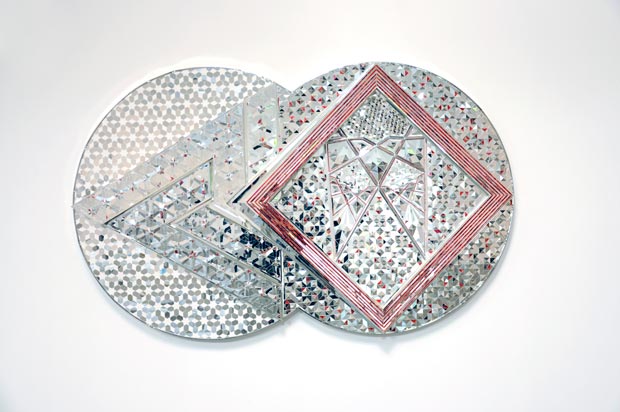 Monir Farmanfarmaian / Square and Triangle, 2010, Mirror, reverse-glass painting and plaster on wood, 100x160 cm / Photo Courtesy of the Artist and The Third Line
Monir Farmanfarmaian / Square and Triangle, 2010, Mirror, reverse-glass painting and plaster on wood, 100x160 cm / Photo Courtesy of the Artist and The Third Line
,2008.jpg) Monir Farmanfarmaian / Untitled (Sculpture 1), 2008 / Photo Courtesy of the Artist and The Third Line
Monir Farmanfarmaian / Untitled (Sculpture 1), 2008 / Photo Courtesy of the Artist and The Third Line
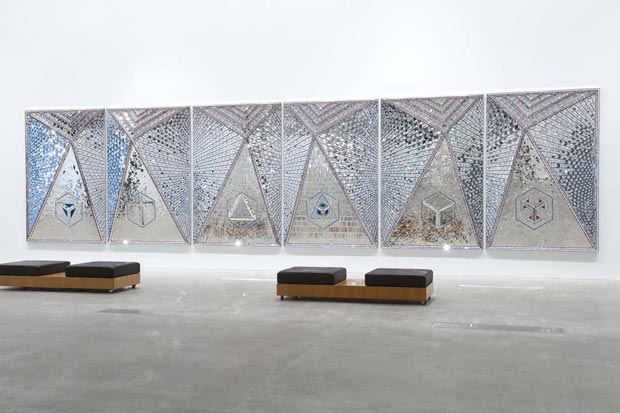 Monir Farmanfarmaian / Lightning for Nedam 2009, Opening Crowds 10 / Photo Courtesy of the Artist and The Third Line
Monir Farmanfarmaian / Lightning for Nedam 2009, Opening Crowds 10 / Photo Courtesy of the Artist and The Third Line
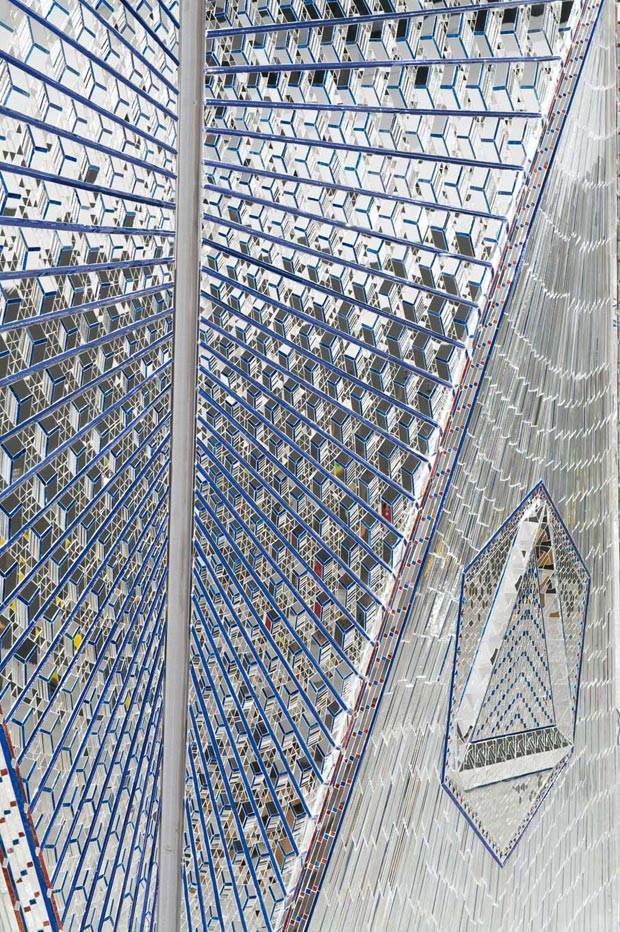 Monir Farmanfarmaian / Lightning for Nedam 2009, Opening Crowds 17 / Photo Courtesy of the Artist and The Third Line
Monir Farmanfarmaian / Lightning for Nedam 2009, Opening Crowds 17 / Photo Courtesy of the Artist and The Third Line
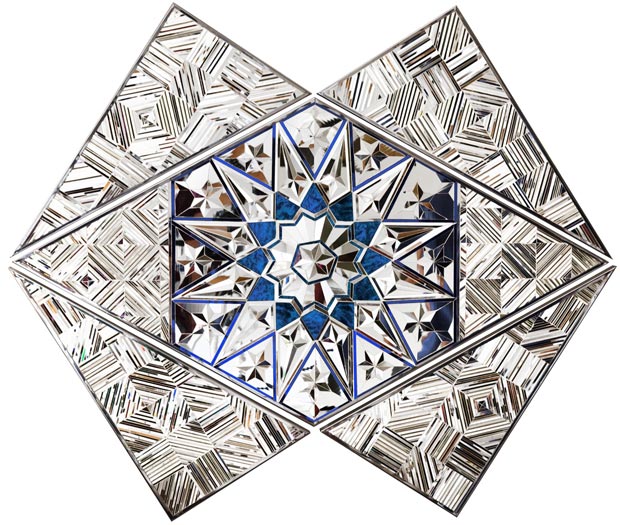 Monir Farmanfarmaian / Convertible Series, G1-V1, 2010, Mirror and reverse glass painting on plaster and wood, Variable size / Photo Courtesy of the Artist and The Third Line
Monir Farmanfarmaian / Convertible Series, G1-V1, 2010, Mirror and reverse glass painting on plaster and wood, Variable size / Photo Courtesy of the Artist and The Third Line
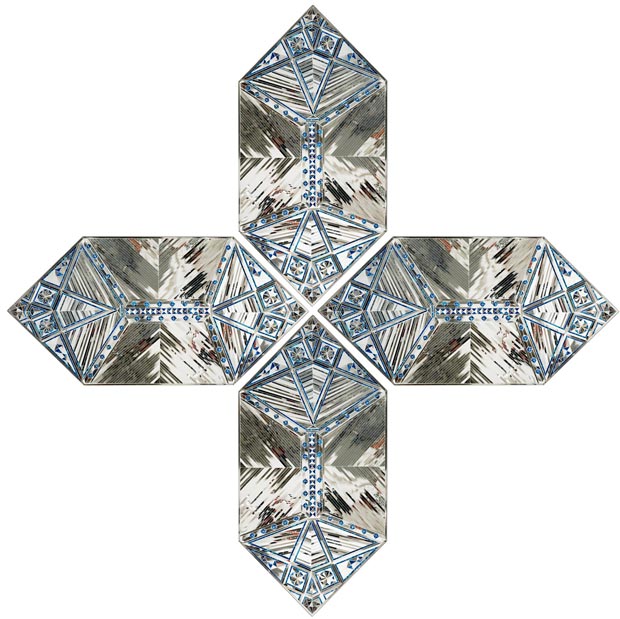 Monir Farmanfarmaian / Convertible Series, G5-V1, 2010, Mirror and reverse glass painting on plaster and wood, Variable size / Photo Courtesy of the Artist and The Third Line
Monir Farmanfarmaian / Convertible Series, G5-V1, 2010, Mirror and reverse glass painting on plaster and wood, Variable size / Photo Courtesy of the Artist and The Third Line
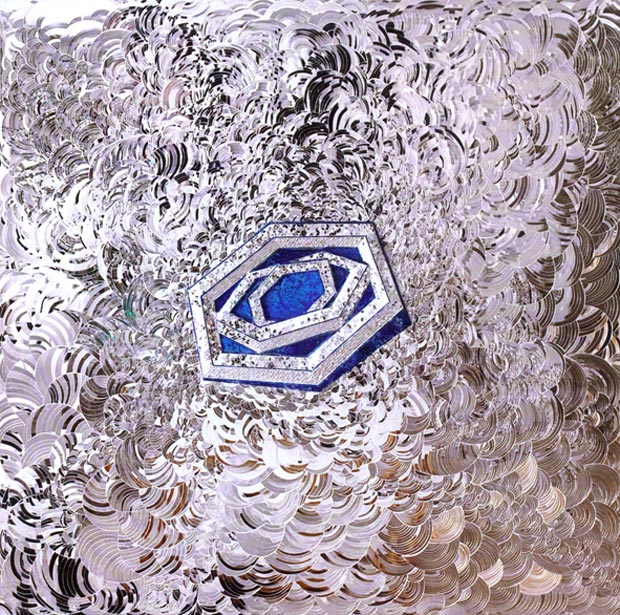 Monir Farmanfarmaian / Flight of the Dolphin, 2010, Mirror mosaic, reverse glass painting, traditional glue and plaster on wood, 650 / Photo Courtesy of the Artist and The Third Line
Monir Farmanfarmaian / Flight of the Dolphin, 2010, Mirror mosaic, reverse glass painting, traditional glue and plaster on wood, 650 / Photo Courtesy of the Artist and The Third Line
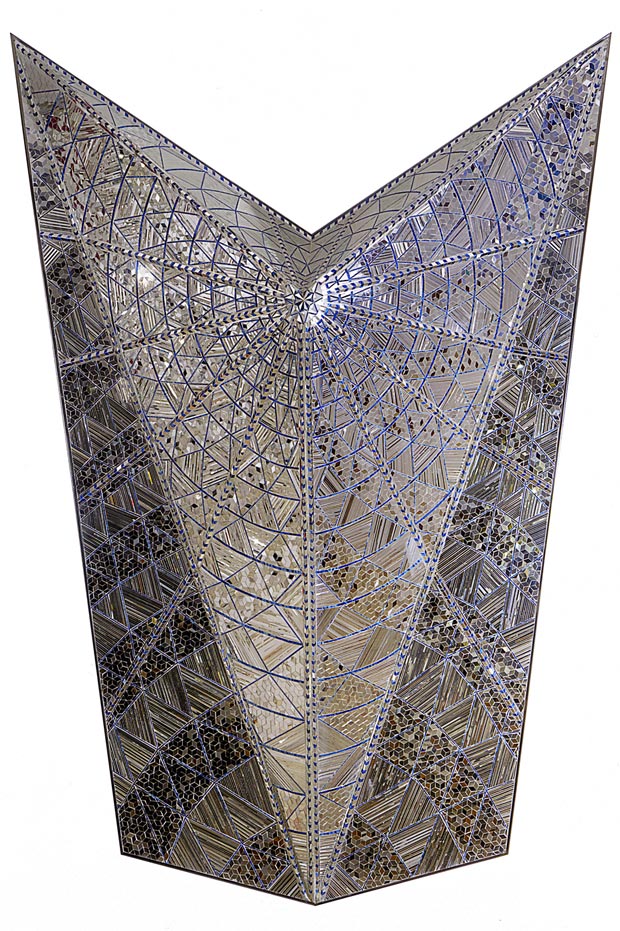 Monir Farmanfarmaian / Magical Triangle, 2011, 200x140x42 cm / Photo Courtesy of the Artist and The Third Line
Monir Farmanfarmaian / Magical Triangle, 2011, 200x140x42 cm / Photo Courtesy of the Artist and The Third Line
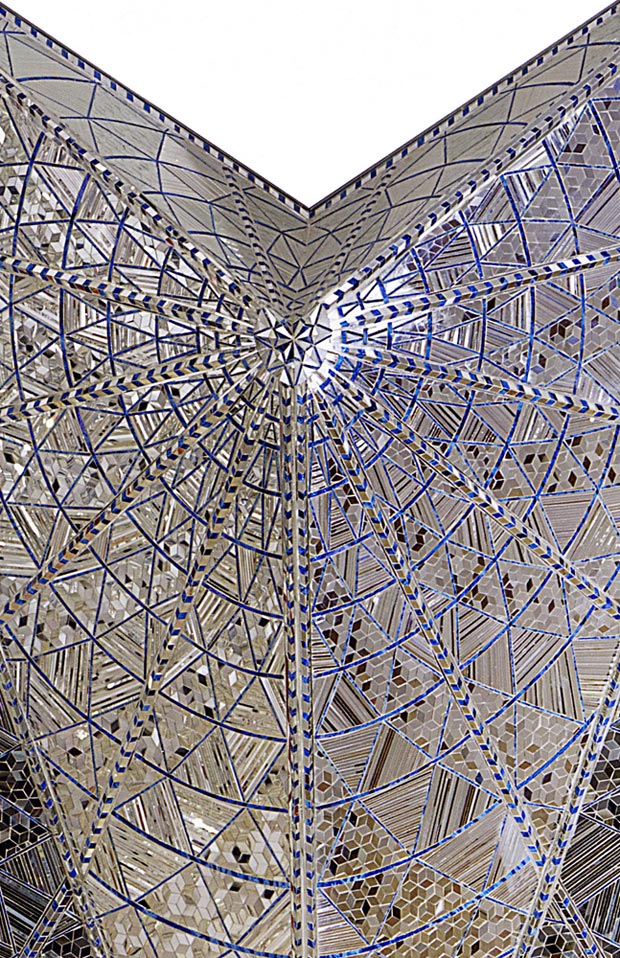 Monir Farmanfarmaian / Magical Triangle, 2011, 200x140x42 cm, detail / Photo Courtesy of the Artist and The Third Line
Monir Farmanfarmaian / Magical Triangle, 2011, 200x140x42 cm, detail / Photo Courtesy of the Artist and The Third Line
_2010_mirror-and-reverse-glass-painting-on-plaster-and-wood_180-x-110-x-4-cm.jpg) Monir Farmanfarmaian / Shahzed's Garden (1), 2010, mirror and reverse glass painting on plaster and wood, 180x110x4 cm / Photo Courtesy of the Artist and The Third Line
Monir Farmanfarmaian / Shahzed's Garden (1), 2010, mirror and reverse glass painting on plaster and wood, 180x110x4 cm / Photo Courtesy of the Artist and The Third Line
Monir was born in Qazvin, Iran, in 1924, where she studied Fine Arts at the Tehran University. She was one of the first Iranian students to travel to the United States after World War II where she completed her studies at Cornell University. Having graduated from Parsons School of Design in 1949, she became a Member of the New York Art Students' League (1950-53).
Her works have been exhibited extensively in Iran, the U.S.A, Europe, and the Middle East, including the Museum of Modern Art, NY; Leighton House Museum, London; Haus der Kunst, Munich; 29th Bienal de Sao Paulo; The Third Line, Dubai; and the Venice Biennale (1958, 1964, 1966 and 2009). Monir’s major commissioned installations include work for the Queensland Art Museum, Australia (2009), the Victoria & Albert Museum’s Jameel Collection (2006), the Dag Hammerskjöd building, NY (1981) and the Niyavaran Cultural Center (1977-78), as well as acquisitions by the Metropolitan Museum, NY; The Tehran Museum of Contemporary Art, the Museum of Contemporary Art Tokyo, and most recently the Guggenheim Museum, NY. More recently, The Third Line and Damiani co-published ‘Monir Shahroudy Farmanfarmaian - Cosmic Geometry’ (2011), an in-depth book edited by Hans Ulrich obrist and Karen Marta, surveying Monir’s work extensively.
Monir currently lives and works in Tehran, Iran.
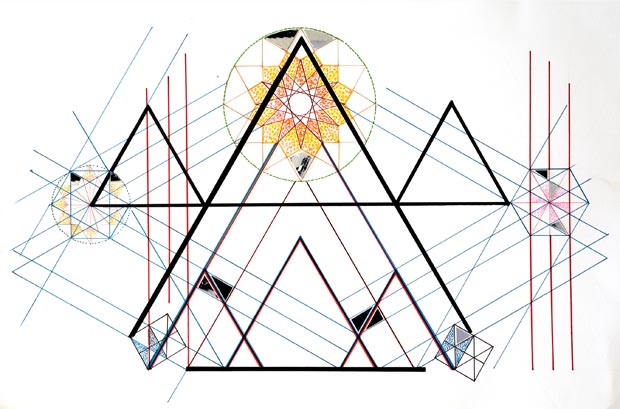 Monir Farmanfarmaian / riangle on Triangle No4, 2008, Felt marker, color pencil & mirror on paper, 60x90 cm / Photo Courtesy of the Artist and The Third Line
Monir Farmanfarmaian / riangle on Triangle No4, 2008, Felt marker, color pencil & mirror on paper, 60x90 cm / Photo Courtesy of the Artist and The Third Line
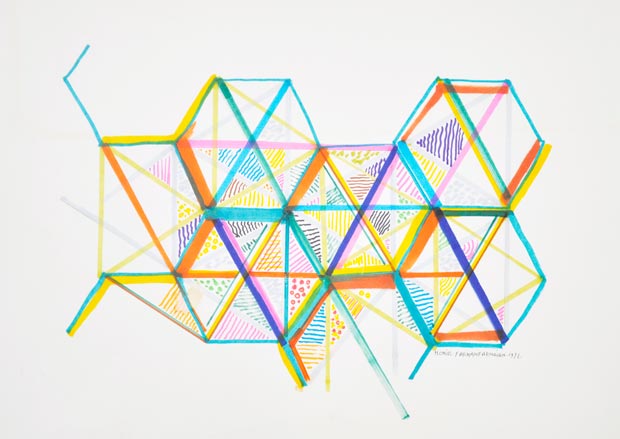 Monir Farmanfarmaian / Variation on a Hexagon 7, 1976, Pencils on paper, 29.5x42 cm / Photo Courtesy of the Artist and The Third Line
Monir Farmanfarmaian / Variation on a Hexagon 7, 1976, Pencils on paper, 29.5x42 cm / Photo Courtesy of the Artist and The Third Line
The Third Line is a Dubai based art gallery that represents contemporary Middle Eastern artists locally, regionally and internationally. In addition to on-going exhibitions, The Third Line hosts non-profit, alternative programs to increase interest and debate in the region. Represented artists include: Abbas Akhavan, Ala Ebtekar, Amir H. Fallah, Arwa Abouon, Babak Golkar, Ebtisam Abdulaziz, Farhad Moshiri, Fouad Elkoury, Golnaz Fathi, Hassan Hajjaj, Hayv Kahraman, Huda Lutfi, Joana Hadjithomas & Khalil Joreige, Lamya Gargash, Laleh Khorramian, Monir Shahroudy Farmanfarmaian, Pouran Jinchi, Rana Begum, Sahand Hesamiyan, Sherin Guirguis, Shirin Aliabadi, Slavs and Tatars, Tarek Al-Ghoussein and Youssef Nabil.
Comments
Add a comment